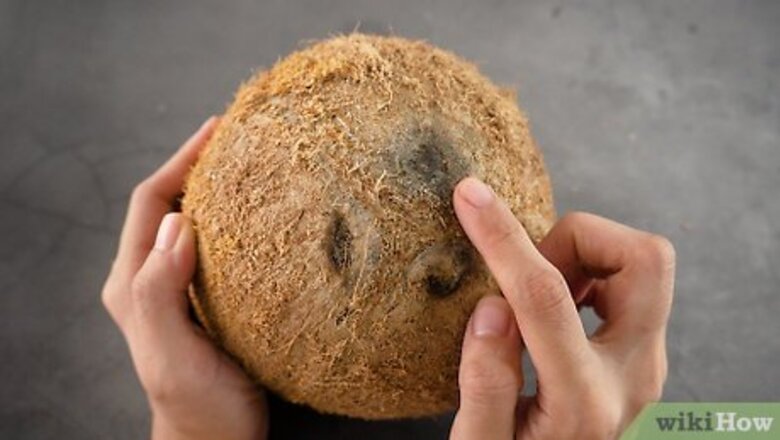
views
- Use a small knife or corkscrew to poke a hole in one of the coconut’s eyes. Let the coconut water drain into a bowl or cup.
- Tap the coconut on its equator using a hammer or the back of a knife. Keep tapping along that same line while rotating the coconut slowly.
- When the coconut cracks open, make small V-shaped cuts in the flesh. Use a small knife to pry out each triangle of fresh coconut meat.
Getting Water Out of the Coconut
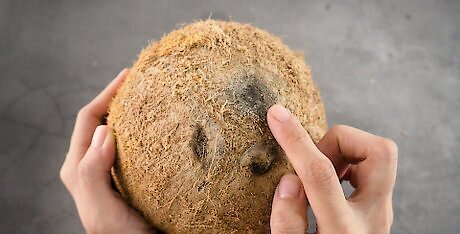
Find the soft eye of the coconut. Like a bowling ball, the coconut will have three "eyes" at one end. Use a knife to test each eye, pointing the tip into an eye to create a hole. Two of the eyes will be hard, while the third will be soft and let you poke through to the meat. These eyes are also known as the coconut's germination pores.

Use a sharp tool to make a hole in the soft eye. This can be done using a knife, drill bit, screwdriver, corkscrew, or other pointed kitchen tool. Create a hole roughly the size of your pinky, poking through the shell until you get to the white meat of the coconut. A meat thermometer is another useful tool. Tap your screwdriver or drill bit gently using a hammer, if necessary.

Drain the coconut water into a bowl, jar, or cup. Hold the coconut upside down over a cup and gently shake the coconut up and down. Let the coconut drain completely before trying to crack it open. Store the coconut water in an airtight container for up to 5-7 days in the refrigerator, or freeze it in ice cube trays to last longer. Drink the coconut water as is, or add it to smoothies, marinades, cocktails, and salad dressings.
Cutting the Coconut in Half
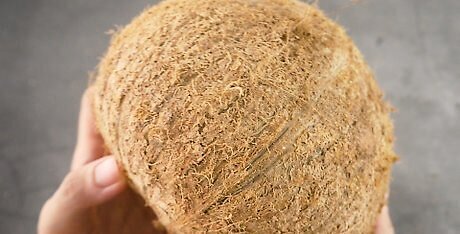
Locate the coconut's equator. This is a thin line along the middle of the coconut, also known as its natural center point. This is where it will be easiest to open the coconut and break it cleanly in half. Find this line before you begin tapping.

Tap along the equator gently until the coconut cracks in half. Start with the coconut in your non-dominant hand, with its three eyes facing out. Using a hammer or mallet, go around the circumference of the coconut, gently hitting the shell. Rotate the coconut as you tap, ensuring you hit each part of the coconut's equator until you hear a cracking sound. Once it starts cracking, use less and less force to keep it in two large pieces. If you use a sharp knife or a machete to open the coconut, use the back of the blade instead of the front. But it’s safer to use a dull object if you have one. Some people use hacksaws to crack open a coconut, but these can be dangerous tools as they easily slip off the coconut. If using a hacksaw, work slowly and cut in short sections all the way around the coconut. Don't worry if your coconut takes some time to crack open—some coconuts are easier to split than others.
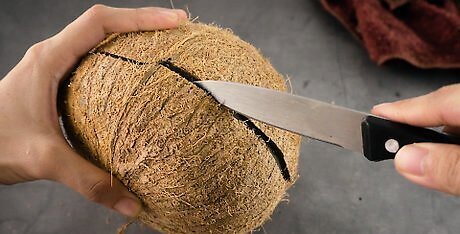
Pry open the coconut if it doesn't separate naturally. If your coconut cracks but doesn't split open, pry open the coconut gently by placing a dull knife in the crack and applying leverage. Situate the knife into the largest crack to help ensure a nice split. Aim for cracks all the way around the coconut before prying it open to make the process easier. Alternatively, you can firmly grasp both halves and forcefully twist them apart. If there’s no liquid inside, put your thumb over the pierced eye of the coconut to create air pressure inside and better facilitate cracking.

Bake the coconut shells to use them for crafting. If you’re not planning to eat fresh coconut meat, place the two coconut halves on a baking sheet. Heat the oven to 175 °F (79 °C) and let the shells bake for 15 minutes to an hour, depending on the size of the coconut. After a few hours of baking, the white meat will easily separate from the shell. You can then use the clean shells as bowls or to make crafts! If any meat doesn’t separate from the shell, press a small steel spatula against the inside of the shell to bend it to the coconut’s shape. Use the now-rounded spatula inside the shell to scrape out the coconut meat.
Removing the Coconut Meat

Hold a coconut section in one hand with your cutting knife in the other. It's best if you hold the coconut in your non-dominant hand to leave your dominant hand for removing the meat. Choose a knife with a curved edge instead of a pointed tip to make the process easier. A paring knife or steak knife works well, but a butter knife can help you avoid cuts or injuries.
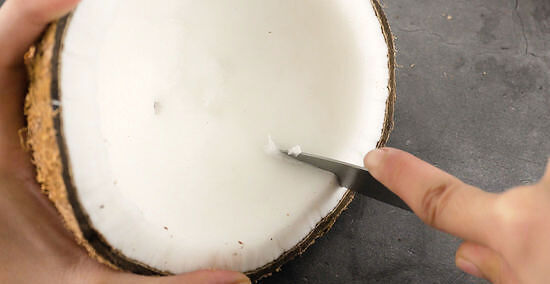
Cut into the coconut, pressing down until you reach the shell. Use your knife to form a perpendicular line from the coconut's cracked edge. Cut deep enough into the flesh of the coconut so that you feel the hard inner shell. The length of this cut is up to you and your knife, though the longer the cut, the more flesh you'll likely be able to pry out at once.
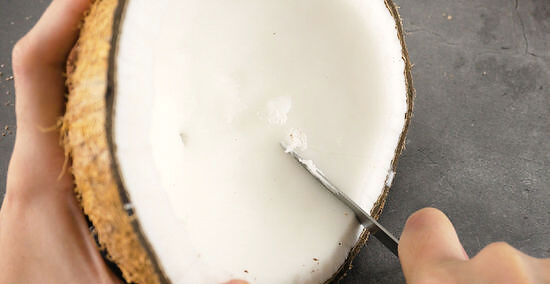
Angle your next cut against the previous cut to form an upside-down V. Once your first cut is finished, form another cut angled out from the original one. This will create a triangular shape or an upside-down V. Press deep enough into this cut to touch the shell, just as you did with the first cut.

Pry the meat from this cut section using a dull knife. Situate your knife under the flesh in the center of your two cuts. Gently pry the meat from this cut section of the coconut, twisting your knife if necessary.

Cut the rest of the sections to remove all of the meat. Continue making upside-down V shapes with the meat, cutting deeply until you reach the shell before prying the meat out. This may take some time, so use caution and be patient! Use this process to remove the meat from the other half of the coconut as well. You can eat the brown skin that sometimes sticks to the coconut meat, but you can also remove it with a vegetable peeler if you prefer.

Use fresh coconut meat in snacks and desserts. You can eat fresh coconut meat and drink the coconut water without cooking or adding anything to them. You can add coconut water to smoothies or use the flesh as a dessert topping. If you want to preserve the coconut for later, shred and dry the coconut meat. Grate the coconut and place it on a baking sheet with your oven set to a low heat, and let the coconut shreds bake until dry to the touch. Dried coconut can be used on anything from ice cream to smoothies to trail mix. You can also make coconut milk and use it in smoothies, desserts, or as a base for soups and curries.



















Comments
0 comment